The focus on user experience (UX) in healthcare has exploded in recent years. Healthcare UX refers to the design of user experience of any digital healthcare product or service. With the growing use of technology in healthcare, more and more interactions are happening online or through digital platforms. There are now countless websites and apps for health tracking, disease management, appointment scheduling, and patient support.
Healthcare and pharma companies strive to provide personalized experience for patients, caregivers, and healthcare providers. However, healthcare is not known for great user experience. Yet, the room for error in healthcare is particularly small, and subpar user experience can have life-altering consequences. Imagine a patient getting so confused during a support program sign-up process that they abandon this effort and do not get access to life-saving medication.
UX in general can be confusing and misunderstood. Layer in the complexities of healthcare, and the topic of healthcare UX can be fraught with myths and misconceptions. Let’s review some of the potential myths and debunk them.
Myth #1: UX in healthcare is only relevant for digital interfaces and tools.
Reality: User experience applies to all aspects of medical care, from medical records and registration processes to appointment scheduling and communication with caregivers. It is important to consider how patients, clinicians, and caregivers interact with every aspect of healthcare services, not just those related to technology. UX design should be applied to physical spaces as well, such as hospitals and clinics, where patients interact with their environment.
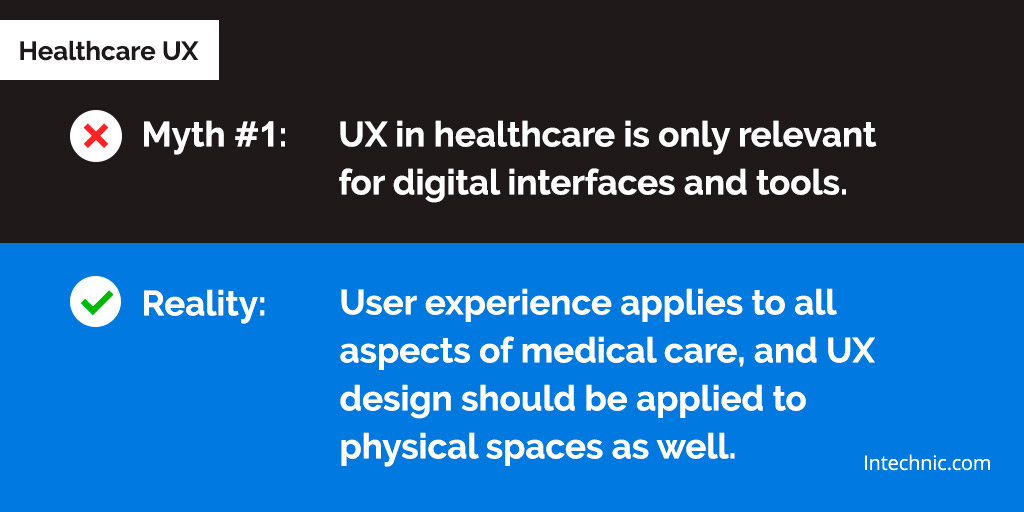
Myth #2: Medical treatment is a necessity, so people will use it even if the UX is not optimal.
Reality: While receiving medical treatment is certainly a top priority for patients, their experience can have a significant impact on whether and how they use the systems that are available to them. Medication adherence rates are actually surprisingly low. Up to 50% of patients do not take their medications as prescribed, and only 3% of patients use the patient support programs provide by the pharma companies.1,2
At Intechnic, our top goal is to provide patients with a positive and guided user experience when they explore their insurance benefits and cost support programs, for example. Improving UX can lead to better patient outcomes, as patients are more likely to adhere to treatment plans and follow recommended care if they feel supported and understood by the healthcare system.
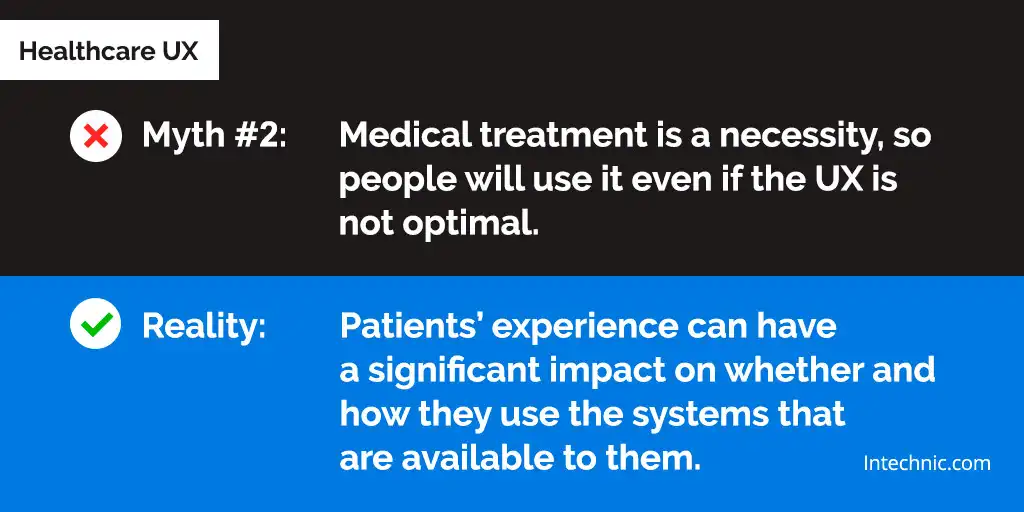
Myth #3: New technology can solve many of the existing problems.
Reality: Technology can only be helpful if it’s being used. It is important to carefully consider the needs and preferences of the users in order to design an effective and meaningful user experience. Simply introducing new technology without considering these factors can just create more problems rather than solve them.
For example, pharmaceutical companies or insurers can roll out new portals or apps, but if patients do not understand how to use these products or do not find them helpful, then it will be more of a burden than assistance. In fact, survey results show that only 3% of patients use support programs created by pharmaceutical companies because they either do not know about them or find them difficult to use.2
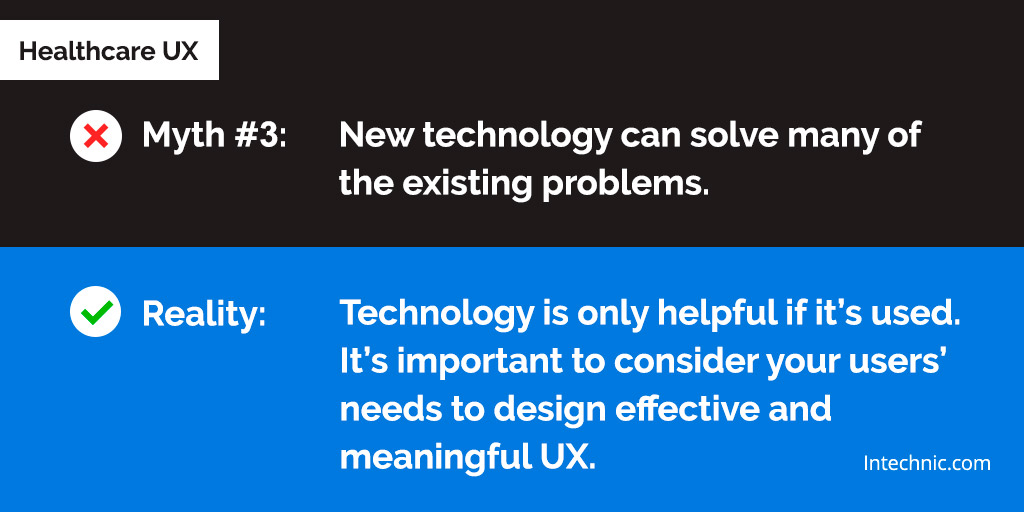
Myth #4: Healthcare UX is no different from UX in general.
Reality: While there are certainly many similarities between user experience in healthcare and other industries, there are also many unique challenges and considerations in healthcare. For example, healthcare technology often involves sensitive and personal information, as well as complex medical terminology and concepts.
While working on healthcare UX projects, we discovered just how difficult it is for patients and caregivers to navigate many of their digital healthcare experiences. From understanding the medical jargon to figuring out the complexities of the insurance and medical systems, users need all the guidance that they can get.
Healthcare UX designers, similarly, must have an in-depth understanding of the industry, regulations, and user needs. They should be familiar with healthcare terminology, compliance requirements, and other nuances involved in designing effective products that meet the needs of patients and providers alike. Patients may also be more likely to have disabilities or be older than the general population.
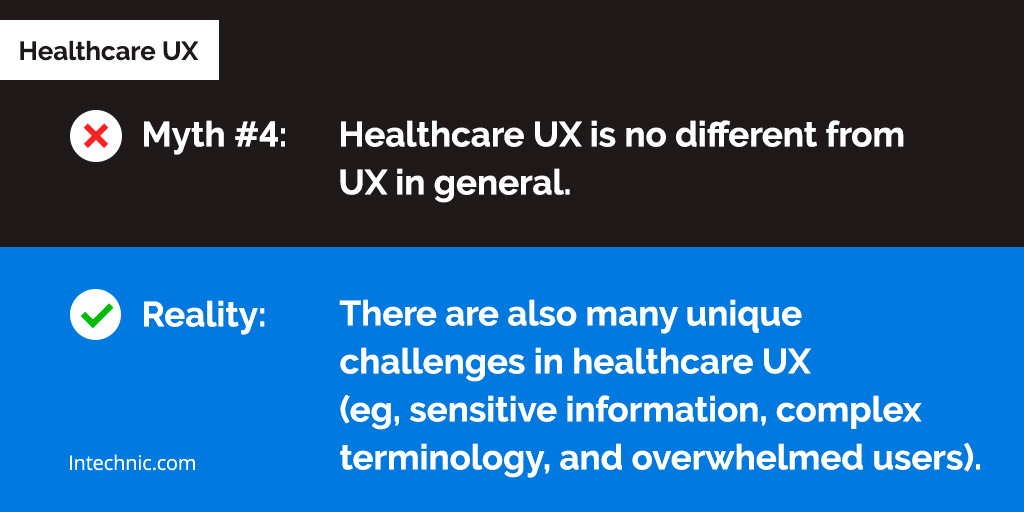
Myth #5: Healthcare UX should only address patient needs.
Reality: Healthcare UX should also consider the workflows and processes of clinicians, administrators, and other healthcare staff. Some digital products, for example those that clinicians use to interact with patients, may need to consider the needs of providers, patients, and caregivers all at once in order to provide all parties with a seamless experience.
According to our research, patients are concerned with feeling supported, being guided through the process, and feeling like their healthcare team is “on their side.” Meanwhile, providers are looking for the fastest, most convenient way to accomplish their goals and use digital tools to provide resources to their patients.
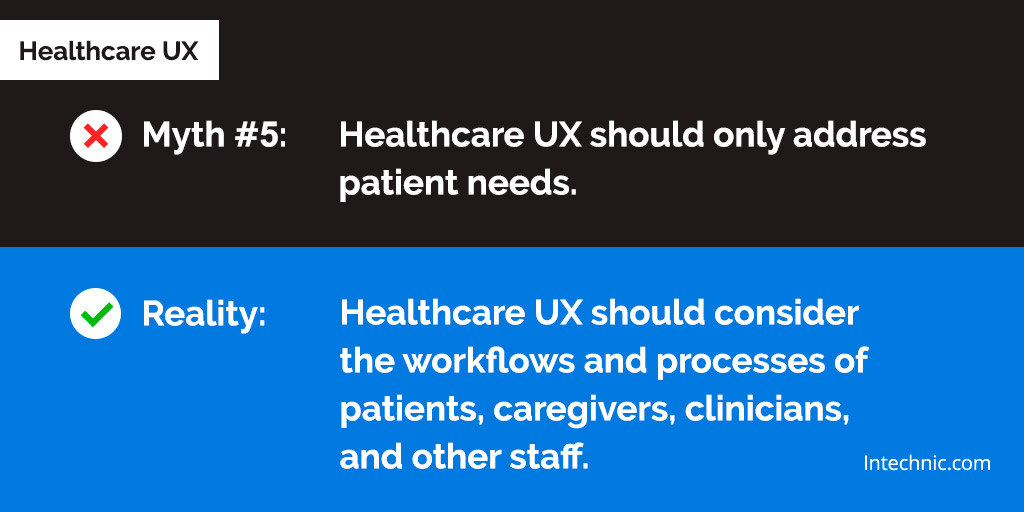
Myth #6: Patients are a homogeneous group.
Reality: If a digital product is created for a very specific condition, this may be true. But more often, patients and their caregivers are as varied as humans in general. An app designed for easy medication refills or insurance claims, for example, may be used by an elderly patient with poor eyesight, a young person with a chronic condition, or a busy parent of a pediatric patient.
A lot of patients’ needs depend on their comfort and competency with technology, as well as the burden associated with an illness. Some patients don't delve too deeply into online resources and rely on their provider to give them information, whereas others find comfort in researching all the information they can get.
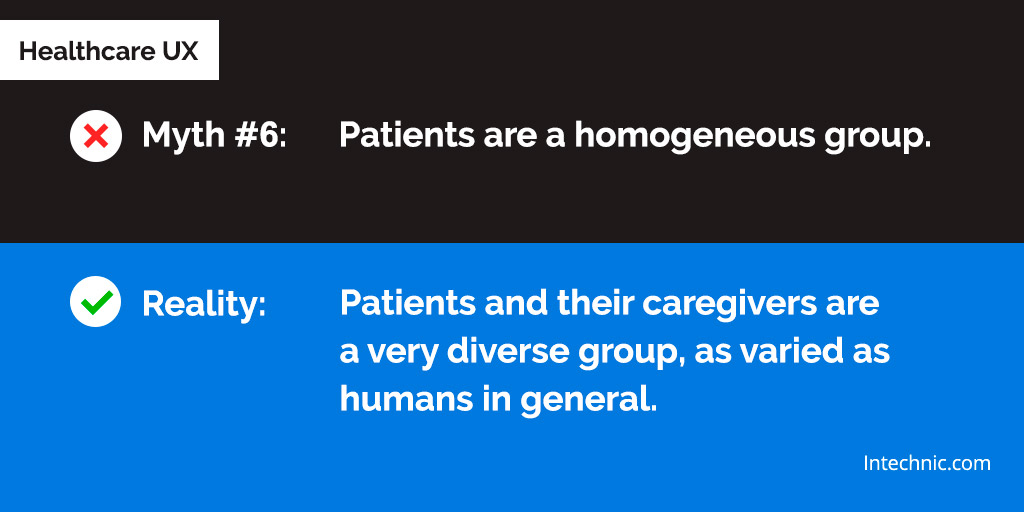
Myth #7: Usability is only about aesthetics and design.
Reality: Designing the best user experience involves understanding users and their goals and behaviors and providing them with a frictionless experience. This implies understanding the context of use, guiding the user and providing meaningful feedback, reducing cognitive load by simplifying design elements, optimizing page loading times, and designing for accessibility. Our main objective is to make sure that the patients feel in control of their healthcare journey and to empower them to make the best decisions for their wellbeing.
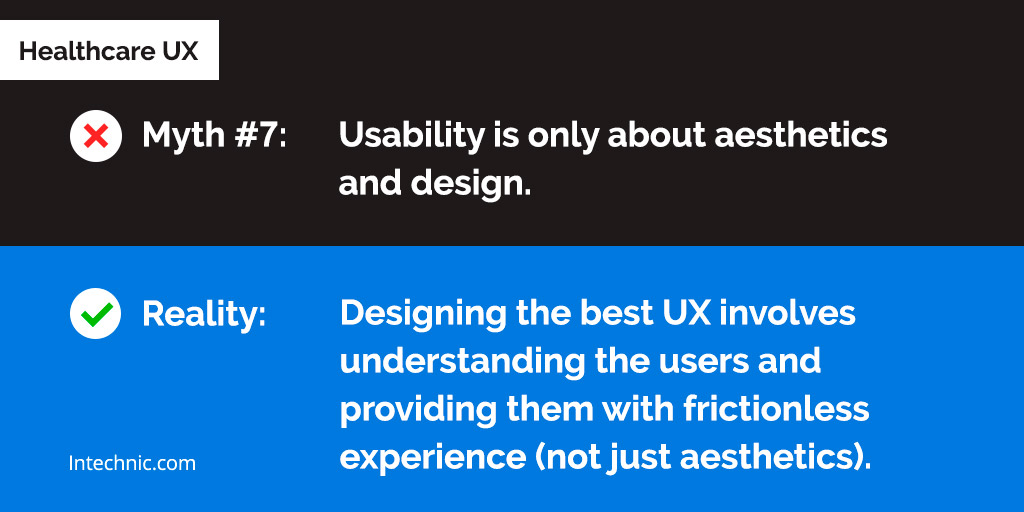
Myth #8: Usability is subjective and not measurable.
Reality: Usability can be measured objectively using metrics that focus on effectiveness, efficiency, and user satisfaction. The Patient Experience (PX) Scale is a revolutionary framework developed by a team of UX researchers specifically to measure the quality of modern digital patient experience in healthcare. It is also crucial to also speak with the patients as we undertake each healthcare project to help us fully understand the problems that we are trying to solve. Conducting usability tests and interviews gets to the “why” when numbers can only tell us “what.”
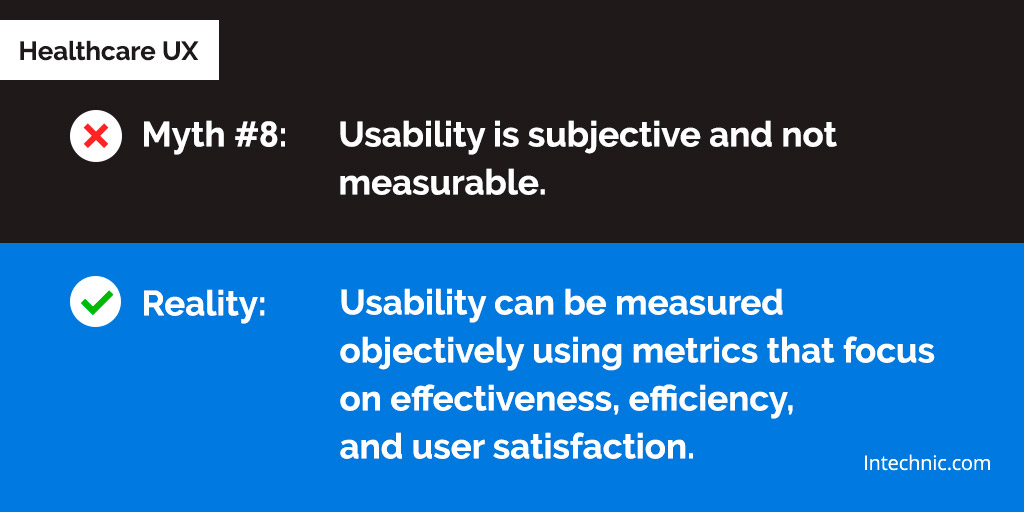
Myth #9: You will never satisfy all the users.
Reality: It is likely not possible to fully satisfy 100% of users, but it is possible to satisfy the vast majority of them. In fact, testing with just five users should be sufficient to discover most usability issues.3 User satisfaction can be measured by the Net Promoter Score (NPS), which is a metric based on a single survey question asking respondents to rate the likelihood that they would recommend a company, product, or service to a friend or colleague.
While working on the sign-up experience for a patient support program, we achieved an NPS of 100, showing that it is possible to satisfy all the users.
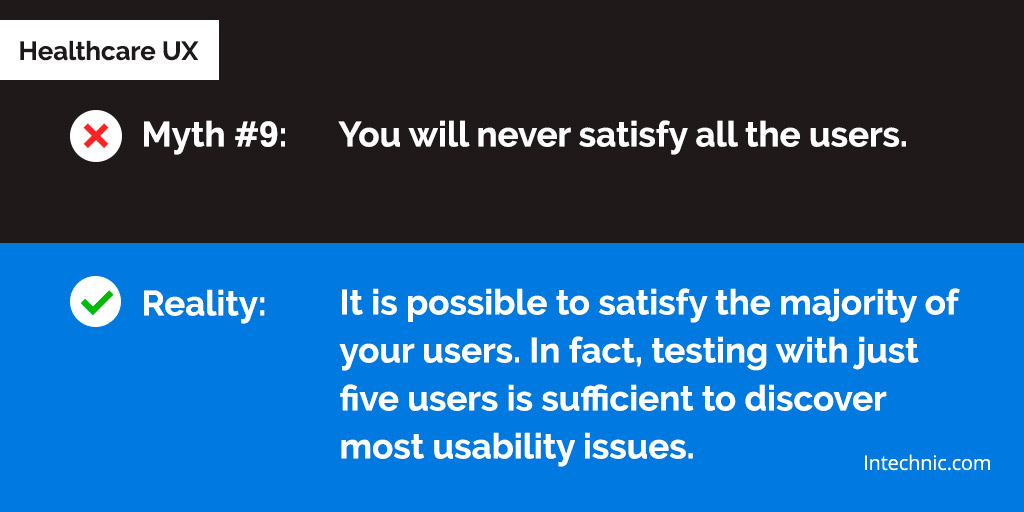
Myth #10: It is too expensive for healthcare companies to invest in UX.
Reality: In fact, it may be too expensive not to invest in UX. Developers spend 50% of their time reworking projects because of poor UX, while investing in UX during a project’s concept phase reduces product development cycles by 33-50%.4 Also, in today’s competitive healthcare market, users have a lot of choices and will switch to a different product if they are not happy with the one they are using. On average, 67% of customers claim unpleasant experiences as a reason for switching brands.5
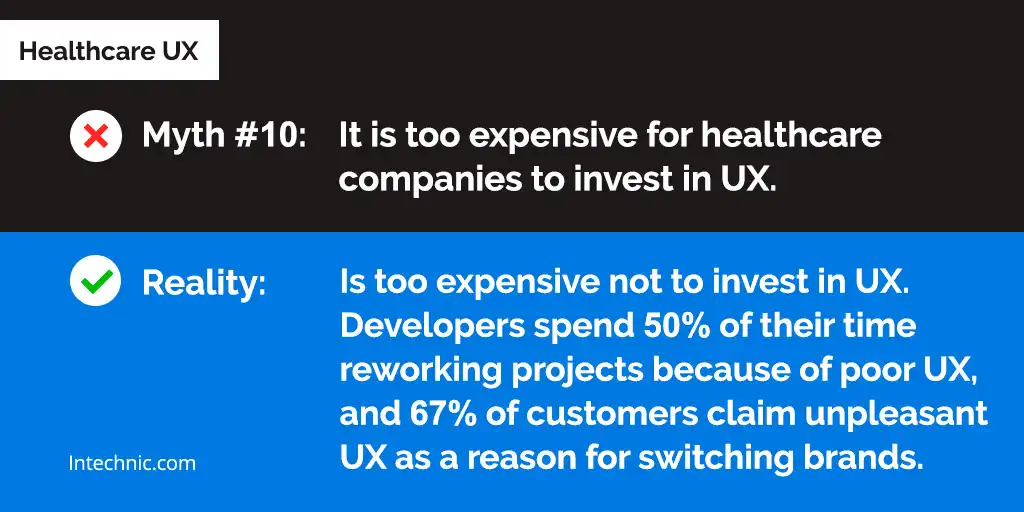
Not sure how your website is performing?
Start with a UX Audit.
In healthcare, better user experience equals fewer errors, higher patient safety, better health outcomes, and improved brand trust and loyalty. You can have the best idea for a product or service, but a successful outcome largely depends on user adoption, ease of use, and the correct application, while guiding, educating, and empathizing with patients, their caregivers, and health care providers.
Are you noticing symptoms of poor UX on your website? Don’t waste time and money with tweaks and changes that may not get you the result you want. We can identify UX problems on your website and help to fix them with a UX Audit.
References
- Association of Diabetes Care & Education Specialists. Fostering Medication Taking: Tips and Tricks. www.diabeteseducator.org/docs/default-source/living-with-diabetes/tip-sheets/medication-taking/fostering_med_adherence.pdf. Accessed February 2023.
- Snyder Bulik B. Pharmas' return on $5B spent yearly on patient support programs? Only 3% are using them: survey. Fierce Pharma. 2021. www.fiercepharma.com/marketing/pharmas-return-5-billion-spent-yearly-patient-support-programs-only-3-use-survey. February 2023.
- Nielsen Norman Group. How Many Test Users in a Usability Study? www.nngroup.com/articles/how-many-test-users. Accessed February 2023.
- IEEE Spectrum. Why Software Fails. spectrum.ieee.org/why-software-fails. Accessed February 2023.
- Esteban Kolsky. CX Stats. www.slideshare.net/ekolsky/cx-for-executives/2. Accessed February 2023.


